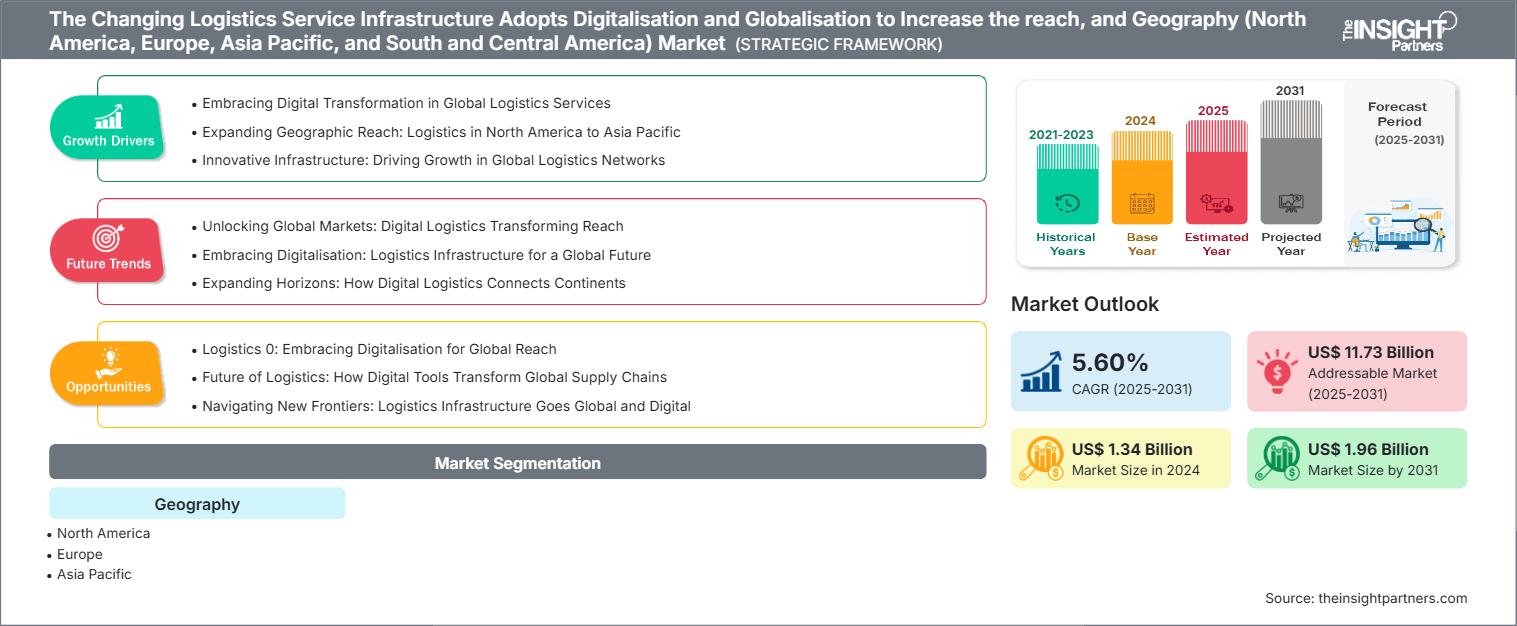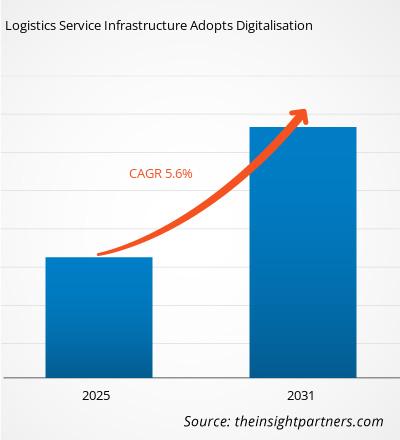물류 서비스 시장은 2021년 10억 7,747만 달러에서 2031년 1조 7,582억 2,000만 달러로 성장할 것으로 전망되며, 2021년부터 2031년까지 연평균 성장률 5.6%로 성장할 것으로 추산됩니다.
운영 효율성 향상에 대한 의존도가 높아지고, 운영 비용 절감을 위해 물류 운영 및 공급망 프로세스 아웃소싱의 인기가 높아지면서 다양한 분야에서 이러한 추세가 가속화되고 있습니다. 또한, 제3자 물류 및 제4자 물류 기업의 등장으로 물류 서비스 제공업체에 대한 글로벌 수요가 증가했습니다. 주요 물류 기업들은 화물 운송, 화물 관리, 컨설팅, 경로 최적화, 네트워크 분석, 프로젝트 관리, 재고 및 보관 관리, 공급망 컨설팅 등을 주요 서비스로 제공합니다. 또한, 실시간 추적 및 모니터링, 분석, 예측, 계획과 같은 기술 기반 물류 서비스 활용을 통해 얻을 수 있는 다양한 이점은 시장 참여자들의 수익성을 더욱 높여줍니다. 물류 서비스 산업은 다양한 물류 서비스를 전문으로 하는 여러 기업이 존재하고 고객 기반이 넓기 때문에 매우 세분화되어 있습니다.
아시아와 아프리카 등 신흥 경제권의 국내 기업들은 꾸준하고 경쟁력 있는 물류 서비스 가격을 통해 시장 경쟁을 더욱 심화시키고 있습니다. 공급망 네트워크는 끊임없이 변화하며 새로운 무역 통로를 열어가고 있습니다. 이러한 새로운 무역 통로를 활용할 수 있는 조직과 국가는 세계 무역 발전에서 가장 큰 이익을 얻을 가능성이 높습니다. 이러한 기회의 일부는 선진국에서는 널리 사용되지만 많은 개발도상국에서는 제한적으로 또는 전혀 구현되지 않은 포괄적인 모범 사례 공유를 통해 창출될 것으로 예상됩니다. 관리 회계 시스템, 다양성 관리, 지식 공유, 이전 자유화 과정에서 도출된 KPI , 그리고 강력한 기업의 사회적 책임( CSR ) 관행 개발과 같은 인력 관리를 위한 전략 및 컨설팅이 필요합니다. 지속적인 투자, 신제품 개발, 그리고 현대적인 기술 통합으로 인해 글로벌 물류 서비스 산업은 향후 몇 년 동안 빠르게 성장할 것으로 예상됩니다. 물류 서비스 시장은 고객에게 최고의 서비스를 제공하기 위해 지속적으로 R&D에 투자하는 몇몇 유명 글로벌 기업들이 주도하고 있습니다. 지리적 발전 및 기술 개선 측면에서 물류 서비스 제공업체, 특히 제3자 서비스 제공업체는 엄청난 성장을 경험하고 있습니다. 예를 들어, 3PL 기업들은 이제 비효율성과 비용을 줄이기 위해 다양한 소프트웨어 기반 솔루션을 운영에 도입하고 있습니다. 또한, 창고 관리 시스템 통신에 음성 인식 소프트웨어를 도입하여 주문 처리 및 재고 기록을 지원함으로써 직원 교육 및 인력 부족을 해소합니다. 아시아 태평양 지역은 물류 서비스 시장에서 큰 비중을 차지하고 있으며, 예측 기간 동안 가장 높은 연평균 성장률(CAGR)을 기록할 것으로 예상됩니다.
이 보고서의 일부 또는 국가 수준 분석, Excel 데이터 팩을 포함하여 모든 보고서에 대한 사용자 정의를 무료로 받을 수 있으며, 스타트업 및 대학을 위한 훌륭한 혜택과 할인도 이용할 수 있습니다.
변화하는 물류 서비스 인프라는 도달 범위와 지리적 위치(북미, 유럽, 아시아 태평양, 남미 및 중미)를 확대하기 위해 디지털화 와 글로벌화를 채택합니다. 시장: 전략적 통찰력

- 이 보고서의 주요 시장 동향을 알아보세요.이 무료 샘플에는 시장 동향부터 추정치 및 예측까지 다양한 데이터 분석이 포함됩니다.
COVID-19 팬데믹이 물류 서비스 시장에 미치는 영향
COVID-19의 발발은 2021년 말과 2021년에 세계 경제에 영향을 미쳤습니다. 여기에는 항공편 취소, 여행 금지 및 격리가 포함되며 전 세계의 전반적인 공급망과 물류 활동이 상당히 둔화되었습니다. 상품의 이동, 보관 및 흐름에 관련된 물류 회사는 COVID-19 팬데믹의 직접적인 영향을 받습니다. 그러나 일부 산업은 팬데믹으로 어려움을 겪고 있는 반면, 의료 및 제약과 같은 다른 산업은 번창하고 있습니다. 전자 상거래 및 생필품도 COVID-19가 발생할 경우 글로벌 물류 산업에 긍정적인 영향을 미칠 것입니다. 또한 병원 용품, 장갑, 소독제, 백신 및 신선 식품과 같은 의료 및 FMCG 공급품에 대한 수요 증가는 COVID-19 팬데믹 속에서 물류 시장의 성장을 촉진하고 있습니다.
물류 서비스 시장:
역방향 물류 운영 증가로 인한 전자상거래 산업의 성장에 대한 시장 통찰력
전자상거래는 인터넷을 통한 상품의 매매를 말합니다. 소비자에게 제품을 배송하는 일반적인 기능 외에도 물류 서비스 제공업체는 전자상거래 사업의 공급망을 관리하고 모니터링하여 전자상거래 산업의 요구를 충족합니다. 이를 통해 이러한 사업은 마케팅 및 기타 사업 운영에 집중할 수 있습니다. 전자상거래 산업에 대한 물류의 이점으로 인해 전 세계적으로 물류 서비스 수용이 크게 증가했습니다. 2021년 4월에 발표된 최신 유엔 무역개발회의(UNCTAD) 보고서에 따르면 2021년 전 세계 전자상거래 매출은 25.6조 달러에 달해 전 세계 국내총생산(GDP)의 약 30%를 차지했습니다. 2021년 전 세계 B2B 전자상거래 사업의 가치는 21조 달러였으며 전 세계 전체 전자상거래의 약 83%를 차지했습니다. 나아가 B2C 전자상거래의 가치는 4.4조 달러였습니다. 이러한 성장은 국경 간 쇼핑의 급격한 급증에 기인합니다. 2021년에는 14억 명이 넘는 사람들이 온라인으로 쇼핑을 했습니다. 미국, 중국, 일본의 기업들이 글로벌 전자상거래 판매를 지배하고 있습니다.
변화하는 물류 서비스 인프라는 도달 범위와 지리적 위치(북미, 유럽, 아시아 태평양, 남미 및 중미)를 확대하기 위해 디지털화와 글로벌화를 채택합니다. 시장 지역 통찰력
Insight Partners의 분석가들은 예측 기간 동안 변화하는 물류 서비스 인프라가 디지털화와 세계화를 통해 도달 범위와 지역(북미, 유럽, 아시아 태평양, 중남미)을 확대하는 데 영향을 미치는 지역별 동향과 요인을 면밀히 분석했습니다. 이 섹션에서는 변화하는 물류 서비스 인프라가 디지털화와 세계화를 통해 도달 범위와 지역(북미, 유럽, 아시아 태평양, 중남미)을 확대하는 데 영향을 미치는 지역별 동향과 요인을 북미, 유럽, 아시아 태평양, 중동 및 아프리카, 중남미의 시장 세그먼트와 지역에 대해서도 다룹니다.
변화하는 물류 서비스 인프라는 도달 범위와 지리적 영역(북미, 유럽, 아시아 태평양, 남미 및 중미)을 확대하기 위해 디지털화와 글로벌화를 채택합니다. 시장 보고서 범위
| 보고서 속성 | 세부 |
|---|---|
| 2024년 시장 규모 | 13억 4천만 달러 |
| 2031년까지 시장 규모 | 19억 6천만 달러 |
| 글로벌 CAGR(2025~2031년) | 5.60% |
| 역사적 데이터 | 2021-2023 |
| 예측 기간 | 2025-2031 |
| 포함된 지역 및 국가 | 북아메리카
|
| 시장 선도 기업 및 주요 회사 프로필 |
|
변화하는 물류 서비스 인프라는 도달 범위와 지리적 위치(북미, 유럽, 아시아 태평양, 남미 및 중미)를 확대하기 위해 디지털화와 글로벌화를 채택합니다. 시장 참여자 밀도: 비즈니스 역학에 미치는 영향 이해
변화하는 물류 서비스 인프라는 디지털화와 세계화를 통해 도달 범위와 지역(북미, 유럽, 아시아 태평양, 중남미)을 확대하고 있습니다. 시장은 소비자 선호도 변화, 기술 발전, 그리고 제품 이점에 대한 인식 제고 등의 요인으로 인해 최종 사용자 수요가 증가함에 따라 빠르게 성장하고 있습니다. 수요가 증가함에 따라 기업들은 제품 및 서비스를 확장하고, 소비자 요구를 충족하기 위한 혁신을 추진하며, 새로운 트렌드를 적극 활용하고 있으며, 이는 시장 성장을 더욱 가속화하고 있습니다.

- 변화하는 물류 서비스 인프라가 도달 범위와 지리적 위치(북미, 유럽, 아시아 태평양, 남미 및 중미)를 확대하기 위해 디지털화와 글로벌화를 채택하고 있다는 주요 주요 참여자 개요를 알아보세요.
운송 수단 기반 시장 통찰력
효율적인 운송은 비교적 안전하게, 적절한 시기에, 적절한 상태로, 그리고 비용 효율적으로 상품을 물리적으로 이동시키는 것을 의미합니다. 운송은 생산 또는 보관 장소에서 사용 또는 유통 장소, 그리고 최종 소비지까지 상품을 이동시키는 역할을 합니다. 운송 방식에 따라 물류 서비스 시장은 도로, 철도, 수로, 항공로로 구분됩니다. 운송 방식 선택 기준은 운송 중인 상품과 화물의 물리적 특성에 따라 결정됩니다. 특정 상황에서는 도로 및 철도 파손과 같은 환경적 요인이 선택 방식에 상당한 영향을 미칠 수 있습니다.
물류 제공업체 기반 시장 통찰력
글로벌 물류 서비스 시장은 구성 요소 유형별로 1자 물류 및 2자 물류, 3자 물류, 4자 물류, 5자 물류로 구분됩니다. 3자 물류 제공업체(3PL)는 기업의 공급망 관리 기능의 일부 또는 전부를 담당하는 물류 서비스를 제공합니다. 3자 공급망 관리자에게 물류를 아웃소싱하는 추세는 지속되고 있습니다. 현재 물류 서비스 시장 규모는 1조 774억 6천만 달러로 추산되며, 물류 서비스의 상당 부분이 3자 물류에 아웃소싱됩니다. 그러나 아웃소싱 수준은 국가별로 상당한 차이를 보입니다. 일반적으로 영국과 미국에서는 아웃소싱이 물류 활동으로 선호되는 반면, 중국과 인도는 3자 물류 사업의 미래 성장 잠재력이 매우 높습니다.
조직 규모 기반 시장 통찰력
물류 서비스는 상품을 한 장소에서 다른 장소로 운송하는 기업에 필수적이며, 이러한 과정의 복잡성을 피하기 위해 다양한 중소기업과 대기업들이 물류 서비스를 도입하고 있습니다. 기술의 급속한 발전으로 인해 많은 중소기업과 대기업들이 물류 서비스를 선택하고 있으며, 이를 통해 핵심 역량 강화, 기업 구조조정, 그리고 비용 절감에 집중할 수 있게 되었습니다. 글로벌 물류 서비스 시장은 기업 규모에 따라 중소기업과 대기업으로 구분됩니다.
제품 개발은 기업들이 제품 포트폴리오를 확장하기 위해 일반적으로 채택하는 전략입니다. FedEx, Maersk, DHL, UPS, Expeditors 등은 물류 서비스 시장에서 고객 기반과 매출 점유율을 확대하기 위해 이러한 전략을 도입하는 주요 업체로, 이를 통해 브랜드 인지도를 유지할 수 있습니다. 최근 몇 가지 주요 동향은 다음과 같습니다.
- 2021년 11월, 글로벌 컨테이너 물류 통합 기업인 AP 몰러-머스크(AP Moller-Maersk)는 사우디 항만청(Saudi Ports Authority)과 20만 5천 제곱미터 규모의 통합 물류 단지를 설립하는 계약을 체결했습니다. 이 단지는 고객에게 창고 및 유통, 저온 보관, 전자상거래를 위한 광범위한 인프라를 제공할 것입니다. 또한, 이 시설은 환적, 석유화학 제품 혼재, 항공 화물, 컨테이너 화물의 허브 역할도 할 것입니다.
- 2021년 1월, FedEx와 Microsoft는 전자상거래 업계를 위한 새로운 크로스 플랫폼 물류 솔루션을 발표했습니다. 이 새로운 솔루션은 고객 참여를 개선하고 향상된 배송 옵션을 제공함으로써 전자상거래 분야에서 가맹점의 경쟁력을 강화하는 것을 목표로 합니다.
물류 서비스 시장은 운송 수단, 물류 제공업체, 기업 규모, 그리고 최종 사용자를 기준으로 세분화됩니다. 운송 수단 기준으로는 도로, 수로, 철도, 항공으로 구분됩니다. 물류 제공업체 기준으로는 1자 물류, 2자 물류, 3자 물류, 4자 물류, 5자 물류로 나뉩니다. 기업 규모 기준으로는 중소기업과 대기업으로, 최종 사용자 기준으로는 정부 및 공공 시설, 의료, 산업 제조, 소매 및 소비재, 항공우주 및 방위, 기타로 세분화됩니다.
CEVA Logistics, Panalpina World Transport (Holding) Ltd., United Parcel Service (UPS), CH Robinson Worldwide, Inc., AP MOLLER – MAERSK, Nippon Express, FedEx, DB Schenker, DHL International GmbH, KUEHNE + NAGEL은 글로벌 물류 서비스 시장에서 활동하는 몇몇 주요 기업입니다.
- 과거 분석(2년), 기준 연도, CAGR을 포함한 예측(7년)
- PEST 및 SWOT 분석
- 시장 규모 가치/거래량 - 글로벌, 지역, 국가
- 산업 및 경쟁 환경
- Excel 데이터세트
최근 보고서
사용 후기
구매 이유
- 정보에 기반한 의사 결정
- 시장 역학 이해
- 경쟁 분석
- 고객 인사이트
- 시장 예측
- 위험 완화
- 전략 기획
- 투자 타당성 분석
- 신흥 시장 파악
- 마케팅 전략 강화
- 운영 효율성 향상
- 규제 동향에 발맞춰 대응






















 무료 샘플 받기 - 변화하는 물류 서비스 인프라는 도달 범위와 지리적 위치(북미, 유럽, 아시아 태평양, 남미 및 중미)를 확대하기 위해 디지털화와 글로벌화를 채택합니다.
무료 샘플 받기 - 변화하는 물류 서비스 인프라는 도달 범위와 지리적 위치(북미, 유럽, 아시아 태평양, 남미 및 중미)를 확대하기 위해 디지털화와 글로벌화를 채택합니다.